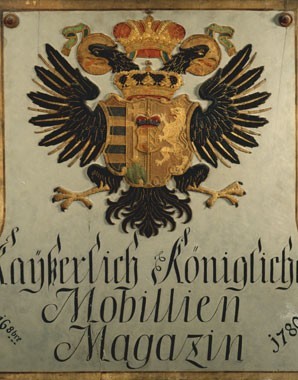What do the Emperor’s apartments look like?
This question had already been asked in the commemorative volume entitled Viribus Unitis published on the occasion of Emperor Francis Joseph’s golden jubilee. But as in so many areas of imperial life, interior design in the House of Habsburg was not just a question of personal taste …
Guards officer Erwein Lobkowicz on Emperor Franz Joseph’s apartment at Schönbrunn (1916). Zitiert nach: Ottillinger, Eva B.: Kaiserliche Wohnkultur; in: Hamann, Brigitte/Hassmann, Elisabeth (Hrsg.): Elisabeth. Stationen ihres Lebens, Wien/München 1998, S. 38 – 45The first large study (the so-called ‘Walnut Room’), a most attractive room, decorated throughout in wood and gold, contained very acceptable furniture … The second study was considerably plainer, mainly appointed with furniture from Crown holdings. Particularly the desk was more than tasteless, a polished brown product of the atrocious furniture style of the seventies … the walls of this room and the bedroom and all the upholstered furniture were covered with heavy, dark-brown silk, decorated with scattered green ivy leaves; it looked old-fashioned, yet somehow original … it was furniture you would no longer see in a better-class household.
Empress Maria Ludovica in a letter of 14 December 1809 to her husband, Emperor Franz I. Zitiert nach: Ottillinger, Eva B.: Interieurs im Wandel. Die "ägyptischen Räume" Kaiserin Ludovicas; in: Barta-Fliedl, Ilsebill/Parenzan, Peter (Hrsg.): Lust und Last des Erbens. Die Sammlungen der Bundesmobilienverwaltung Wien, Wien 1993, S. 73 – 81As far as my apartment is concerned, you know my weakness better than anyone, my best darling …. I don’t deny that the expense will be great, but everything will remain in the ownership of the State (as aulic property) … what I cost you in furnishings, another woman would cost you in horses, balls, entertainments – I ask for none of those, merely a handsome apartment …
It was customary to redesign and redecorate the imperial apartments with every change of ruler. Certain traditions and expectations had to be taken into consideration, for the residence of the ruler was accessible – at least for an exclusive section of the public – and also served as a statement of power and status. On the one hand, the illustriousness of the imperial Court had to be upheld, for a certain level of pomp was expected in order to conform to contemporary notions of rank and its outward representation. On the other hand, ever since Maria Theresa the principle of modest housekeeping had had priority at the Viennese Court: solid quality was preferred to short-lived fashionable trends, and excessive opulence was to be avoided.
This resulted in an assemblage of furnishings that had been accumulated over the years rather than created as a single integrated design: old furniture frequently stood next to new, historic furnishings were often ‘improved’ with modern details. Moreover, there was a distinction between privately owned effects, paid for by the various owners from the House of Habsburg, and aulic property, which was acquired through state funds. While the former was at the disposal of the heirs on the owner’s death, the latter was transferred to the holdings of the Hofmobilienverwaltung, the body that administered the household effects at all the imperial residences.
The furnishing and decoration of residential apartments for the Habsburgs was not always a question of personal taste. Individual predilections frequently had to be sacrificed in favour of what might be referred to as ‘corporate identity’. The best example is the type of neo-Rococo associated from the 1830s with the Viennese Court and known as the ‘Maria Theresa’ or ‘Blondel’ style. The ‘classic’ version of the white and gold painted furniture with red damask upholstery in particular was deemed the decorative style most befitting for the ‘decorum of the supreme Court’.
The members of the dynasty differed in their ambitions relating to the decoration of their apartments: for instance, the third wife of Emperor Franz I, Maria Ludovica, had particularly high standards and had her suite of 24 rooms in the Hofburg opulently decorated in the very latest fashion of the day, the neo-Classical Empire style. At the other end of the scale were those Habsburgs who had little or no interest in interior design: the frugality of Franz Joseph is legendary; he aged alongside the furnishings with which his apartments had been fitted when he moved into them, without ever feeling the need for a change.


















